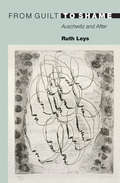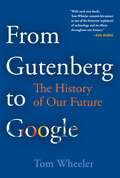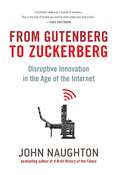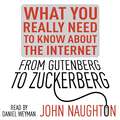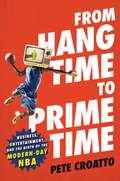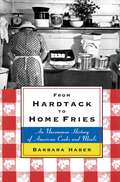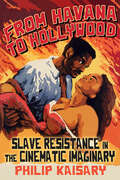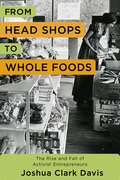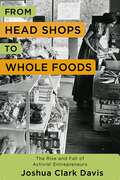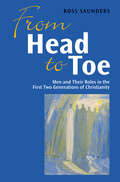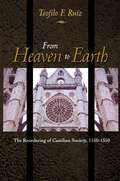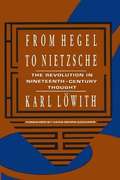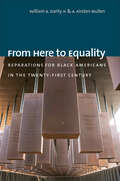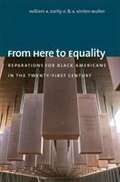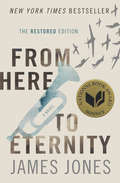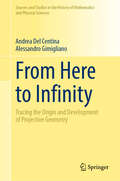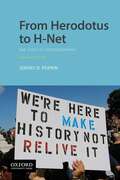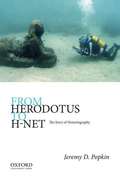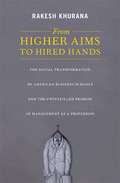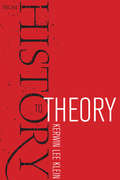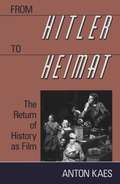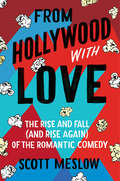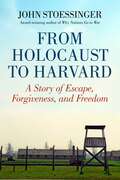- Table View
- List View
From Guilt to Shame: Auschwitz and After (20/21 #8)
by Ruth LeysWhy has shame recently displaced guilt as a dominant emotional reference in the West? After the Holocaust, survivors often reported feeling guilty for living when so many others had died, and in the 1960s psychoanalysts and psychiatrists in the United States helped make survivor guilt a defining feature of the "survivor syndrome." Yet the idea of survivor guilt has always caused trouble, largely because it appears to imply that, by unconsciously identifying with the perpetrator, victims psychically collude with power. In From Guilt to Shame, Ruth Leys has written the first genealogical-critical study of the vicissitudes of the concept of survivor guilt and the momentous but largely unrecognized significance of guilt's replacement by shame. Ultimately, Leys challenges the theoretical and empirical validity of the shame theory proposed by figures such as Silvan Tomkins, Eve Kosofsky Sedgwick, and Giorgio Agamben, demonstrating that while the notion of survivor guilt has depended on an intentionalist framework, shame theorists share a problematic commitment to interpreting the emotions, including shame, in antiintentionalist and materialist terms.
From Gutenberg To Google: The History Of Our Future
by Tom WheelerIn an era of seemingly instant change, it's easy to think that today's revolutions--in communications, business, and many areas of daily life--are unprecedented. Today's changes may be new and may be happening faster than ever before. But our ancestors at times were just as bewildered by rapid upheavals in what we now call "networks"--the physical links that bind any society together. <p><p> In this fascinating book, former FCC chairman Tom Wheeler brings to life the two great network revolutions of the past and uses them to help put in perspective the confusion, uncertainty, and even excitement most people face today. The first big network revolution was the invention of movable-type printing in the fifteenth century. This book, its millions of predecessors, and even such broad trends as the Reformation, the Renaissance, and the multiple scientific revolutions of the past 500 years would not have been possible without that one invention. The second revolution came with the invention of the telegraph early in the nineteenth century. Never before had people been able to communicate over long distances faster than a horse could travel. Along with the development of the world's first high-speed network--the railroad--the telegraph upended centuries of stability and literally redrew the map of the world. <p> Wheeler puts these past revolutions into the perspective of today, when rapid-fire changes in networking are upending the nature of work, personal privacy, education, the media, and nearly every other aspect of modern life. But he doesn't leave it there. Outlining "What's Next," he describes how artificial intelligence, virtual reality, blockchain, and the need for cybersecurity are laying the foundation for a third network revolution.
From Gutenberg to Zuckerberg: What You Really Need to Know About the Internet
by John NaughtonJohn Naughton is the Observer's 'Networker' columnist, a prominent blogger, and Vice-President of Wolfson College, Cambridge. The Times has said that his writings, "[it] draws on more than two decades of study to explain how the internet works and the challenges and opportunities it will offer to future generations," and Cory Doctrow raved that "this is the kind of primer you want to slide under your boss's door." In From Gutenberg to Zuckerberg, Naughton explores the living history of one of the most radically transformational technologies of all time. From Gutenberg to Zuckerberg is a clear-eyed history of one of the most central, and yet most taken-for-granted, features of modern life: the internet. Once a technological novelty and now the very plumbing of the Information Age, the internet is something we have learned to take largely for granted. So, how exactly has our society become so dependent upon a utility it barely understands? And what does it say about us that this is so? While explaining in highly engaging language the way the internet works and how it got to be the way it is, technologist John Naughton has distilled the noisy chatter surrounding the technology's relentless evolution into nine essential areas of understanding. In doing so, he affords readers deeper insight into the information economy and supplies the requisite knowledge to make better use of the technologies and networks around us, highlighting some of their fascinating and far-reaching implications along the way.From the Hardcover edition.
From Gutenberg to Zuckerberg: What You Really Need to Know About the Internet
by John NaughtonJohn Naughton is the Observer's â??Networker' columnist, a prominent blogger, and Vice-President of Wolfson College, Cambridge. The Times has said that his writings, "[it] draws on more than two decades of study to explain how the internet works and the challenges and opportunities it will offer to future generations," and Cory Doctrow raved that "this is the kind of primer you want to slide under your boss's door." In From Gutenberg to Zuckerberg, Naughton explores the living history of one of the most radically transformational technologies of all time. From Gutenberg to Zuckerberg is a clear-eyed history of one of the most central, and yet most taken-for-granted, features of modern life: the internet. Once a technological novelty and now the very plumbing of the Information Age, the internet is something we have learned to take largely for granted. So, how exactly has our society become so dependent upon a utility it barely understands? And what does it say about us that this is so? While explaining in highly engaging language the way the internet works and how it got to be the way it is, technologist John Naughton has distilled the noisy chatter surrounding the technology's relentless evolution into nine essential areas of understanding. In doing so, he affords readers deeper insight into the information economy and supplies the requisite knowledge to make better use of the technologies and networks around us, highlighting some of their fascinating and far-reaching implications along the way.(P)2013 Quercus Editions Ltd
From Hang Time to Prime Time: Business, Entertainment, and the Birth of the Modern-Day NBA
by Pete CroattoPerfect for fans of Moneyball and The Book of Basketball, this vivid, thoroughly entertaining, and well-researched book explores the NBA&’s surge in popularity in the 1970s and 1980s and its transformation into a global cultural institution. Far beyond simply being a sports league, the NBA has become an entertainment and pop culture juggernaut. From all kinds of team logo merchandise to officially branded video games and players crossing over into reality television, film, fashion lines, and more, there is an inseparable line between sports and entertainment. But only four decades ago, this would have been unthinkable. Featuring writing that leaps off the page with energy and wit, journalist and basketball fan Pete Croatto takes us behind the scenes to the meetings that lead to the monumental American Basketball Association–National Basketball Association merger in 1976, revolutionizing the NBA&’s image. He pays homage to legendary talents including Julius &“Dr. J&” Erving, Magic Johnson, and Michael Jordan and reveals how two polar-opposite rookies, Larry Bird and Magic Johnson, led game attendance to skyrocket and racial lines to dissolve. Croatto also dives into CBS&’s personality-driven coverage of key players, as well as other cable television efforts, which launched NBA players into unprecedented celebrity status. Essential reading whether you&’re a casual or longtime fan, From Hang Time to Prime Time is an enthralling and entertaining celebration of basketball history.
From Hardtack to Homefries: An Uncommon History of American Cooks and Meals
by Barbara HaberBarbara Haber, one of America's most respected authorities on the history of food, has spent years excavating fascinating stories of the ways in which meals cooked and served by women have shaped American history. As any cook knows, every meal, and every diet, has a story -- whether it relates to presidents and first ladies or to the poorest of urban immigrants. From Hardtack to Home Fries brings together the best and most inspiring of those stories, from the 1840s to the present, focusing on a remarkable assembly of little-known or forgotten Americans who determined what our country ate during some of its most trying periods. Haber's secret weapon is the cookbook. She unearths cookbooks and menus from rich and poor, urban and rural, long-past and near-present and uses them to answer some fascinating puzzles: Why was the food in Franklin and Eleanor Roosevelt's White House so famously bad? Were they trying to keep guests away, or did they themselves simply lack the taste to realize the truth? It turns out that Eleanor's chef wrote a cookbook, which solves the mystery. How did food lure settlers to the hardship of the American West? Englishman Fred Harvey's Harvey Girls tempted them with good food and good women. How did cooking keep alive World War II Army and Navy POWs in the Pacific? A remarkable cookbook reveals how recollections of home cooking and cooking resourcefulness helped mend bodies and spirits.From Hardtack to Home Fries uses a light touch to survey a deeply important subject. Women's work and women's roles in America's past have not always been easy to recover. Barbara Haber shows us that a single, ubiquitous, ordinary-yet-extraordinary lens can illuminate a great deal of this other half of our past. Haber includes sample recipes and rich photographs, bringing the food of bygone eras back to life. From Hardtack to Home Fries is a feast, and a delight.
From Havana to Hollywood: Slave Resistance in the Cinematic Imaginary (SUNY series, Afro-Latinx Futures)
by Philip KaisaryFrom Havana to Hollywood examines the presence or absence of Black resistance to slavery in feature films produced in either Havana or Hollywood—including Gillo Pontecorvo's Burn!, neglected masterpieces by Cuban auteurs Tomás Gutiérrez Alea and Sergio Giral, and Steve McQueen's Oscar-winning 12 Years a Slave. Philip Kaisary argues that, with rare exceptions, the representation of Black agency in Hollywood has always been, and remains, taboo. Contrastingly, Cuban cinema foregrounds Black agency, challenging the ways in which slavery has been misremembered and misunderstood in North America and Europe. With powerful, richly theorized readings, the book shows how Cuban cinema especially recreates the past to fuel visions of liberation and asks how the medium of film might contribute to a renewal of emancipatory politics today.
From Head Shops to Whole Foods: The Rise and Fall of Activist Entrepreneurs
by Joshua C. DavisIn the 1960s and '70s, a diverse range of storefronts--including head shops, African American bookstores, feminist businesses, and organic grocers--brought the work of the New Left, Black Power, feminism, environmentalism, and other movements into the marketplace. Through shared ownership, limited growth, and democratic workplaces, these activist entrepreneurs offered alternatives to conventional profit-driven corporate business models. By the middle of the 1970s, thousands of these enterprises operated across the United States--but only a handful survive today. Some, such as Whole Foods Market, have abandoned their quest for collective political change in favor of maximizing profits. Vividly portraying the struggles, successes, and sacrifices of these unlikely entrepreneurs,From Head Shops to Whole Foodswrites a new history of social movements and capitalism by showing how activists embraced small businesses in a way few historians have considered. The book challenges the widespread but mistaken idea that activism and political dissent are inherently antithetical to participation in the marketplace. Joshua Clark Davis uncovers the historical roots of contemporary interest in ethical consumption, social enterprise, buying local, and mission-driven business, while also showing how today's companies have adopted the language--but not often the mission--of liberation and social change.
From Head Shops to Whole Foods: The Rise and Fall of Activist Entrepreneurs (Columbia Studies in the History of U.S. Capitalism)
by Joshua DavisIn the 1960s and ’70s, a diverse range of storefronts—including head shops, African American bookstores, feminist businesses, and organic grocers—brought the work of the New Left, Black Power, feminism, environmentalism, and other movements into the marketplace. Through shared ownership, limited growth, and democratic workplaces, these activist entrepreneurs offered alternatives to conventional profit-driven corporate business models. By the middle of the 1970s, thousands of these enterprises operated across the United States—but only a handful survive today. Some, such as Whole Foods Market, have abandoned their quest for collective political change in favor of maximizing profits.Vividly portraying the struggles, successes, and sacrifices of these unlikely entrepreneurs, From Head Shops to Whole Foods writes a new history of social movements and capitalism by showing how activists embraced small businesses in a way few historians have considered. The book challenges the widespread but mistaken idea that activism and political dissent are inherently antithetical to participation in the marketplace. Joshua Clark Davis uncovers the historical roots of contemporary interest in ethical consumption, social enterprise, buying local, and mission-driven business, while also showing how today’s companies have adopted the language—but not often the mission—of liberation and social change.
From Head to Toe: Men and Their Roles in the First Two Generations of Christianity
by Ross SaundersFrom Head to Toe invites us to into the world of men in the first two generations of Christianity as they come to terms with what it means to follow Jesus. We share in their struggles and triumphs as they make the journey 'from head to toe' - from status-seeking to serving.Ross Saunders shows us how to read the New Testament with new eyes and hearts, exploring our own understanding of authority, leadership and service within the household of God.
From Heaven to Earth: The Reordering of Castilian Society, 1150-1350
by Teofilo F. RuizBetween the late twelfth century and the mid fourteenth, Castile saw a reordering of mental, spiritual, and physical space. Fresh ideas about sin and intercession coincided with new ways of representing the self and emerging perceptions of property as tangible. This radical shift in values or mentalités was most evident among certain social groups, including mercantile elites, affluent farmers, lower nobility, clerics, and literary figures--"middling sorts" whose outlooks and values were fast becoming normative. Drawing on such primary documents as wills, legal codes, land transactions, litigation records, chronicles, and literary works, Teofilo Ruiz documents the transformation in how medieval Castilians thought about property and family at a time when economic innovations and an emerging mercantile sensibility were eroding the traditional relation between the two. He also identifies changes in how Castilians conceived of and acted on salvation and in the ways they related to their local communities and an emerging nation-state. Ruiz interprets this reordering of mental and physical landscapes as part of what Le Goff has described as a transition "from heaven to earth," from spiritual and religious beliefs to the quasi-secular pursuits of merchants and scholars. Examining how specific groups of Castilians began to itemize the physical world, Ruiz sketches their new ideas about salvation, property, and themselves--and places this transformation within the broader history of cultural and social change in the West.
From Hegel to Nietzsche: The Revolution in Nineteenth-Century Thought
by David E. Green Karl LowithBeginning with an examination of the relationship between Hegel and Goethe, Lowith discusses how Hegel's students, particularly Marx and Kierkegaard, interpreted----or reinterpreted----their master's thought, and proceeds with an in-depth assessment of the other important philosophers, from Feuerbach, Stirner, and Schelling to Nietzsche.
From Here to Equality: Reparations for Black Americans in the Twenty-First Century
by William A. Darity A. Kirsten MullenRacism and discrimination have choked economic opportunity for African Americans at nearly every turn. At several historic moments, the trajectory of racial inequality could have been altered dramatically. Perhaps no moment was more opportune than the early days of Reconstruction, when the U.S. government temporarily implemented a major redistribution of land from former slaveholders to the newly emancipated enslaved. But neither Reconstruction nor the New Deal nor the civil rights struggle led to an economically just and fair nation. Today, systematic inequality persists in the form of housing discrimination, unequal education, police brutality, mass incarceration, employment discrimination, and massive wealth and opportunity gaps. Economic data indicates that for every dollar the average white household holds in wealth the average black household possesses a mere ten cents. In From Here to Equality, William Darity Jr. and A. Kirsten Mullen confront these injustices head-on and make the most comprehensive case to date for economic reparations for U.S. descendants of slavery. After opening the book with a stark assessment of the intergenerational effects of white supremacy on black economic well-being, Darity and Mullen look to both the past and the present to measure the inequalities borne of slavery. Using innovative methods that link monetary values to historical wrongs, they next assess the literal and figurative costs of justice denied in the 155 years since the end of the Civil War. Finally, Darity and Mullen offer a detailed roadmap for an effective reparations program, including a substantial payment to each documented U.S. black descendant of slavery. Taken individually, any one of the three eras of injustice outlined by Darity and Mullen--slavery, Jim Crow, and modern-day discrimination--makes a powerful case for black reparations. Taken collectively, they are impossible to ignore.
From Here to Equality: Reparations for Black Americans in the Twenty-first Century
by William A. Darity A. Kirsten MullenRacism and discrimination have choked economic opportunity for African Americans at nearly every turn. At several historic moments, the trajectory of racial inequality could have been altered dramatically. Perhaps no moment was more opportune than the early days of Reconstruction, when the U.S. government temporarily implemented a major redistribution of land from former slaveholders to the newly emancipated enslaved. But neither Reconstruction nor the New Deal nor the civil rights struggle led to an economically just and fair nation. Today, systematic inequality persists in the form of housing discrimination, unequal education, police brutality, mass incarceration, employment discrimination, and massive wealth and opportunity gaps. Economic data indicates that for every dollar the average white household holds in wealth the average black household possesses a mere ten cents. <P><P> In From Here to Equality, William Darity Jr. and A. Kirsten Mullen confront these injustices head-on and make the most comprehensive case to date for economic reparations for U.S. descendants of slavery. After opening the book with a stark assessment of the intergenerational effects of white supremacy on black economic well-being, Darity and Mullen look to both the past and the present to measure the inequalities borne of slavery. Using innovative methods that link monetary values to historical wrongs, they next assess the literal and figurative costs of justice denied in the 155 years since the end of the Civil War. Finally, Darity and Mullen offer a detailed roadmap for an effective reparations program, including a substantial payment to each documented U.S. black descendant of slavery. Taken individually, any one of the three eras of injustice outlined by Darity and Mullen--slavery, Jim Crow, and modern-day discrimination--makes a powerful case for black reparations. Taken collectively, they are impossible to ignore.
From Here to Eternity: The Restored Edition (The World War II Trilogy #1)
by James JonesA novel of army life in the calm before Pearl Harbor: A New York Times bestseller, a National Book Award winner, and &“one of the great books of our time&” (Newsday). At the Pearl Harbor army base in 1941, Robert E. Lee Prewitt is Uncle Sam&’s finest bugler. A career soldier with no patience for army politics, Prewitt becomes incensed when a commander&’s favorite wins the title of First Bugler. His indignation results in a transfer to an infantry unit whose commander is less interested in preparing for war than he is in boxing. But when Prewitt refuses to join the company team, the commander and his sergeant decide to make the bugler&’s life hell. An American classic now available with scenes and dialogue considered unfit for publication in the 1950s, From Here to Eternity is a stirring picture of army life in the months leading up to the attack on Pearl Harbor. This ebook features an illustrated biography of James Jones including rare photos from the author&’s estate.
From Here to Infinity: Tracing the Origin and Development of Projective Geometry (Sources and Studies in the History of Mathematics and Physical Sciences)
by Andrea Del Centina Alessandro GimiglianoThis monograph traces the development of projective geometry from its Greek origins to the early 20th century. It covers Renaissance perspective studies and insights from the late sixteenth to seventeenth centuries, examining the contributions of Desargues and Pascal. Most of the book is devoted to the evolution of the subject in the 19th century, from Carnot to von Staudt. In particular, the book offers an unusually thorough appreciation of Brianchon's work, a detailed study of Poncelet's innovations, and a remarkable account of the contributions of Möbius and Plücker. It also addresses the difficult question of the historical relationship between synthetic and analytic points of view in geometry, analyzing the work of prominent synthetic geometers Steiner, Chasles, and von Staudt in detail. The book concludes around 1930, after the synthetic point of view was axiomatized and the analytic point of view became intertwined with algebraic geometry. Balancing historical analysis with technical precision and providing deep insights into the evolution of the mathematics, this richly illustrated book serves as a central reference on the history of projective geometry.
From Herodotus to H-Net: The Story of Historiography
by Jeremy D. PopkinFrom Herodotus to H-Net: The Story of Historiography, Second Edition, offers a concise but comprehensive and up-to-date account of the many ways history has been studied and recounted, from the ancient world to the new universe of the Internet. Clearly written and organized, it shows how the same issues that historians debate today were already recognized in past centuries, and how the efforts of historians in the past remain relevant today. Balanced and fair-minded, the book covers the development of modern academic scholarship, but also helps students appreciate the contributions of popular historians and of the many forms of public history. Often drawing on what historians from Edward Gibbon to Natalie Zemon Davis have written about their own careers, From Herodotus to H-Net, Second Edition, brings the discipline of history alive for students and general readers.
From Herodotus to H-net: The Story of Historiography
by Jeremy D. PopkinFrom Herodotus to H-Net: The Story of Historiography offers a concise yet comprehensive and up-to-date account of the many ways in which history has been studied and recounted, from the ancient world to the new universe of the Internet. It shows how the same issues that historians debate today were already recognized in past centuries, and how the efforts of historians in the past remain relevant today. Balanced and fair-minded, the book covers the development of modern academic scholarship, but also helps students appreciate the contributions of popular historians and public history.
From Higher Aims to Hired Hands: The Social Transformation of American Business Schools and the Unfulfilled Promise of Management as a Profession
by Rakesh Khurana"I have been waiting for years for someone to write the definitive institutional history of U. S. management education, and this is it. From the standpoint of most analytic definitions of 'professional,'the term 'professional manager' is enigmatic, even oxymoronic. Rakesh Khurana's thorough, insightful, provocative, and courageous history of business education explains how this term came to make practical and cultural sense to a generation of Americans, and how its logic has been undermined in the past thirty years. "From Higher Aims to Hired Hands" is an exemplary work of institutional analysis, combining first-rate historiography with outstanding social-science scholarship. It will be essential reading for business historians, students of management and organizations, and faculty, administrators, and thoughtful students at America's business schools. "--Paul DiMaggio, Princeton University" "From Higher Aims to Hired Hands" is a tour de force. With profound depth and sweeping scope, Rakesh Khurana analyses the rise and potential fall of a uniquely American institution--one that has influenced management education throughout the world. His book contributes significantly to explaining how managerial capitalism could go awry and how to restore the moral underpinnings that would make management the profession of leadership. In addition to offering fascinating history lessons based on exhaustive research, Khurana adds new twists to institutional theory and points to future directions for educational practice. "--Rosabeth Moss Kanter, Harvard Business School, author of "The Change Masters, Confidence," and "America the Principled: 6 Opportunities for Becoming a Can-Do Nation OnceAgain" "This panoramic portrait of the origins and ramifications of American business education is quite remarkable, rich in detail, powerful in the marshaling of evidence, and provocative in its claims. Khurana writes with confidence, authority, and erudition. "--Walter Powell, Stanford University "This is a wonderful and important book for anyone interested in business education. There is a tendency for those of us involved in business education to think that we understand the dynamics of our industry and that there is little new that we can learn. How wrong such a judgment would be. In providing a sociological understanding of the origins of business education and the professionalization of management, this book prompts deep reflection about the state of management today and offers real insight into the challenges of elevating the standards of this particular profession. "--Joel Podolny, dean of Yale School of Management
From History to Theory
by Kerwin Lee KleinFrom History to Theory describes major changes in the conceptual language of the humanities, particularly in the discourse of history. In seven beautifully written, closely related essays, Kerwin Lee Klein traces the development of academic vocabularies through the dynamically shifting cultural, political, and linguistic landscapes of the twentieth century. He considers the rise and fall of "philosophy of history" and discusses past attempts to imbue historical discourse with scientific precision. He explores the development of the "meta-narrative" and the post-Marxist view of history and shows how the present resurgence of old words--such as "memory"--in new contexts is providing a way to address marginalized peoples. In analyzing linguistic changes in the North American academy, From History to Theory innovatively ties semantic shifts in academic discourse to key trends in American society, culture, and politics.
From Hitler to Heimat: The Return of History as Film
by Anton KaesWest German filmmakers have tried to repeatedly over the past half-century to come to terms with Germany’s stigmatized history. How can Hitler and the Holocaust, how can the complicity and shame of the average German be narrated and visualized? How can Auschwitz be reconstructed? Anton Kaes argues that a major shift in German attitudes occurred in the mid-1970s―a shift best illustrated in films of the New German Cinema, which have focused less on guilt and atonement than on personal memory and yearning for national identity.
From Hitler's U-Boats to Khruschev's Spyflights: Twenty Five Years with Flight Lieutenant Thomas Buchanan Clark, RAF
by Chris ClarkeThis book tells the tale of the illustrious Royal Air Force career of Tom Clark, a World War Two gunner and post-war signaller in action during some of the most pivotal events of the twentieth century. Lovingly penned by his son, it provides an authentic insight into this dynamic period of world history.From work as an air gunner, involved in the daunting task of taking on the might of Hitler's U-boat fleet, to post-war involvement in an Intelligence capacity during the dramatic events surrounding Khrushchev and the atomic threat of the late 1950s, Clark's career was dramatic and varied to say the least. Having joined the RAF as an aircraft man just before the Second World War, Clark was destined to take part in a whole range of wartime operational engagements. His career featured involvement in the famous 1941 hunt for the elusive Bismarck, the dangers of life as part of an Air Sea Rescue squadron in conflicted waters, and the experience of training as a gunnery leader (later an instructor), training air gunners for the famed Desert Air Force. His career also took in a fraught period behind enemy lines, when his crew of four were shot down in enemy territory in Northern Italy. Seven weeks in a safe house in Florence are relayed in engaging and dramatic style, as are a raft of other personal and professional achievements, set within the context of the wider conflict. Here is a career that deserves to be recorded and celebrated, and there is perhaps no-one better placed than the subject's son to act as custodian to his thrilling story.
From Hittite to Homer:
by Bachvarova Mary R.This book provides a groundbreaking reassessment of the prehistory of Homeric epic. It argues that in the Early Iron Age bilingual poets transmitted to the Greeks a set of narrative traditions closely related to the one found at Bronze-Age Hattusa, the Hittite capital. Key drivers for Near Eastern influence on the developing Homeric tradition were the shared practices of supralocal festivals and venerating divinized ancestors, and a shared interest in creating narratives about a legendary past using a few specific storylines: theogonies, genealogies connecting local polities, long-distance travel, destruction of a famous city because it refuses to release captives, and trying to overcome death when confronted with the loss of a dear companion. Professor Bachvarova concludes by providing a fresh explanation of the origins and significance of the Greco-Anatolian legend of Troy, thereby offering a new solution to the long-debated question of the historicity of the Trojan War.
From Hollywood with Love: The Rise and Fall (and Rise Again) of the Romantic Comedy
by Scott MeslowAn in-depth celebration of the romantic comedy’s modern golden era and its role in our culture, tracking the genre from its heyday in the ’80s and the ’90s, its unfortunate decline in the 2000s, and its explosive reemergence in the age of streaming, featuring exclusive interviews with the directors, writers, and stars of the iconic films that defined the genre.No Hollywood genre has been more misunderstood—or more unfairly under-appreciated—than the romantic comedy. Funny, charming, and reliably crowd-pleasing, rom-coms were the essential backbone of the Hollywood landscape, launching the careers of many of Hollywood’s most talented actors and filmmakers, such as Julia Roberts and Matthew McConaughey, and providing many of the yet limited creative opportunities women had in Hollywood. But despite—or perhaps because of—all that, the rom-com has routinely been overlooked by the Academy Awards or snobbishly dismissed by critics. In From Hollywood with Love, culture writer and GQ contributor Scott Meslow seeks to right this wrong, celebrating and analyzing rom-coms with the appreciative, insightful critical lens they’ve always deserved. Beginning with the golden era of the romantic comedy—spanning from the late ’80s to the mid-’00s with the breakthrough of films such as When Harry Met Sally—to the rise of streaming and the long-overdue push for diversity setting the course for films such as the groundbreaking, franchise-spawning Crazy Rich Asians, Meslow examines the evolution of the genre through its many iterations, from its establishment of new tropes, the Austen and Shakespeare rewrites, the many love triangles, and even the occasional brave decision to do away with the happily ever after. Featuring original black-and-white sketches of iconic movie scenes and exclusive interviews with the actors and filmmakers behind our most beloved rom-coms, From Hollywood with Love constructs oral histories of our most celebrated romantic comedies, for an informed and entertaining look at Hollywood’s beloved yet most under-appreciated genre.
From Holocaust to Harvard: A Story of Escape, Forgiveness, and Freedom
by John StoessingerA true and touching human tale of survival and achievement.When John Stoessinger was ten years old, Adolf Hitler annexed his homeland of Austria, ripping the boy from his home and his friends in Vienna. His grandparents encouraged his mother and stepfather to take young John somewhere safe. "You must have a future,” his grandfather told him before he and his parents boarded the train and waved goodbye.As they trekked across the country, from Vienna to Prague and then finally settling in Shanghai, there was never a single moment Stoessinger was not afraid-he lived in constant fear that he and his family would be found and killed. However, even in Hitler-ruled Nazi Germany, there were plenty of people who refused to cower to absolute evil and who did everything they could to usher families like Stoessinger’s to freedom.In From Holocaust to Harvard, Stoessinger recalls heartbreaking moments from his childhood and of living a life of secrets in Shanghai. He then presents the second part of his story-the part where he attempts to untangle himself from his previous life and devastating memories and is able to relocate to America, earn a graduate-level degree from a prestigious university, and later become a member of the Council on Foreign Relations despite making a decision that nearly lands him in prison and threatens his hard-earned freedom.Throughout his story, Stoessinger expresses his gratitude to those who helped him through the toughest parts of this life and put him on a path that led him to a Harvard education, a successful career, and inner peace.Skyhorse Publishing, along with our Arcade, Good Books, Sports Publishing, and Yucca imprints, is proud to publish a broad range of biographies, autobiographies, and memoirs. Our list includes biographies on well-known historical figures like Benjamin Franklin, Nelson Mandela, and Alexander Graham Bell, as well as villains from history, such as Heinrich Himmler, John Wayne Gacy, and O. J. Simpson. We have also published survivor stories of World War II, memoirs about overcoming adversity, first-hand tales of adventure, and much more. While not every title we publish becomes a New York Times bestseller or a national bestseller, we are committed to books on subjects that are sometimes overlooked and to authors whose work might not otherwise find a home.
